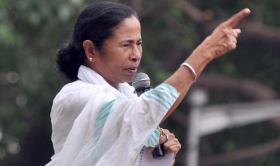July 6, 2015
With Trinamool Congress in driver’s seat, State on a development path

By Avirup Sarkar
No one will deny that West Bengal’s ride over the last four years, with TMC in the driver’s seat, has been bumpy in patches. About the pleasantness of the rest of the journey, opinions might differ though.
The ponzi scams, the occasional unrest in colleges and universities, the sporadic violence in the countryside have all been picked up too eagerly by a section of the media and projected as major failings of the government. The episodes have gained some popularity in certain quarters. So much so that TMC bashing has become a favorite drawing room pastime in the snooty Bengali upper-class. Yet the ruling party has been maintaining its winning streak and is expected to do so in the foreseeable future.
One may call this a puzzle.If we were to interpret the negative reports in the media as total collapse of the administrative process, how do we explain the ruling party’s electoral success? If we take the electoral success as a signal of good governance, how are we to interpret the negative reports projected in the media?
The most canvassed answer to this puzzle is that the political achievement of TMC is the fallout of rigged elections supported by brute force of hooligans and institutional patronage from the police. The answer seems untenable. One must remember that even the all powerful CPM with all its might and ploy could not withstand public anger when it got into the land-grab game.If the present rulers were really as bad as they are made out to be, one would have witnessed similar public anger which no amount of hooliganism or police support could withstand. Moreover, a number of field studies reveal that in West Bengal election results cannot be explained by malpractices alone.
The truth is indeed straight forward. Despite the bad patches, TMC’s performance has been quite satisfactory, especially in the villages, and its electoral victory reflects this simple ground reality. After coming to power, the TMC introduced a deep administrative reform which is seldom advertized. Governance at the grass-root level was taken away from political entities and handed over to officials like BDOs, SDOs and DMs who could be directly controlled and made answerable by the top administration.
Compared to the earlier system practised by the CPM, where the party boss at the local level had the ultimate say, and where the government official had to wait for his nod before making the slightest move, the new system entailed a fundamental change. In the new system, the bureaucrat has more power and responsibilities but at the same time he is always under the scanner of the Chief Minister who with an inexorable energy travels from district to district to assess the ground reality with her own eyes. No other Chief Minister of West Bengal had taken so much pain and work-load.
Her hard work has paid off in a number of ways. For one thing, conditions of roads in rural Bengal have immensely improved. The habitual traveler in the countryside will vouch for this. The improvement is not limited to relatively important passages like the Kalyani Expressway or the state highway connecting Jalpaiguri with Siliguri, but extends to obscure village roads as well. Second, there has been a remarkable improvement in the implementation of welfare schemes, both old, like MGNREGA, and new, like Kanyashree. The latter, being an example of Conditional Cash Transfer to which the whole developing world is gradually switching, reflects the alert and aware mind of the person at the top who designed it.Third, there has been a serious drive to buy food grains directly from the farmers. On the one hand, this is destined to provide support to the tillers of the soil, and fuel the public distribution system on the other.
Procurement had reached a nadir during the Left Front rule, despite its tall claims of upholding the farmers’ interest. The list of achievements could go on and on mentioning the execution of fair price shops, fulfillment of rural electrification targets, giving a very pretty look to the city of Kolkata, removal of militant trade unionism from the state, accomplishing spectacular growth in the number of new schools, colleges and universities, reduction in red-tapes and so on and so forth.
The fabulous development efforts have been supported by an impressive growth in the government’s own tax revenue which in turn has been made possible by far reaching structural and administrative reforms of the finance ministry. Compared to the previous regime, the growth rate of government’s own tax revenue has almost doubled over the past four years.
Finally , political unrest has subsided in Jangalmahal and Darjeeling, thanks to the frequent visits of the Chief Minister. In short, the state of West Bengal is on a path of development which is endorsed and rewarded by the voters.
The author is a professor of economics at Indian Statistical Institute, Kolkata
(Published on Times of India, dated 6 July, 2015)
